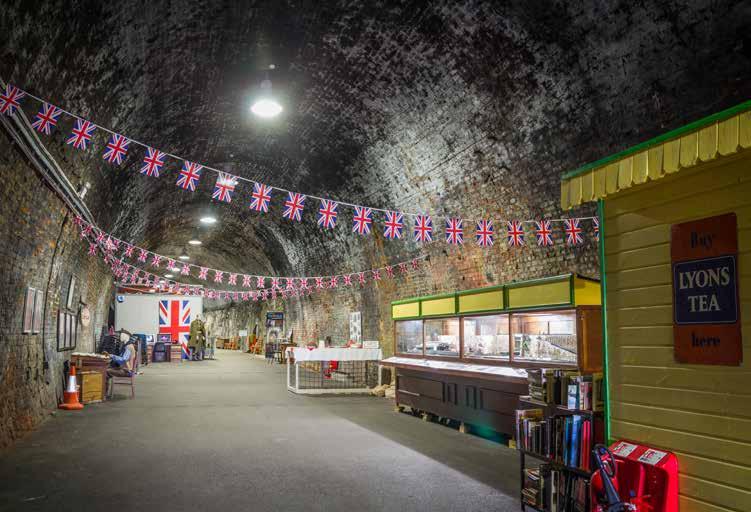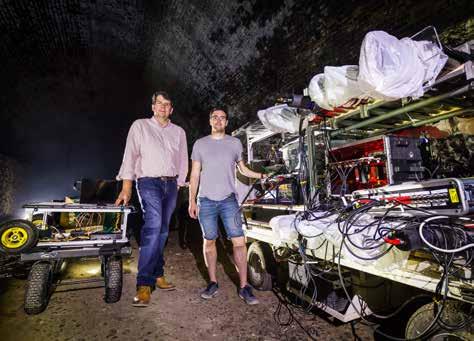
10 minute read
What the eye cannot see
STRUCTURES/INFRASTRUCTURE
What the eyeCANNOT SEE
GRAEME BICKERDIKE
Dr Chris Steer and Dr Patrick Stowell check data below the ventilation shaft.
Some things make my brain hurt: Channel Four’s Naked Attraction, all Apple products, the cost of HS2. But, most recently, I’ve found myself befuddled by a scientist’s assertion that we are constantly being rained upon by subatomic particles which pass through anything and everything as they head deep into the Earth.
What’s even more baffling is that these particles have value in asset management terms. In fact, they have the potential to help the railway draw a line under a longstanding concern both of Network Rail and the Office of Rail and Road, by confirming the location of many-dozen hidden construction shafts, sunk when our inventory of tunnels was driven during the Victorian era but for which records no longer exist.
Science lesson
Cosmic rays are produced where solar and extra-galactic particles collide with the upper atmosphere, causing a further shower of particles which fall towards the Earth’s surface. Of those that make it all the way, the majority are muons; these typically have a rate of 10,000 per square metre per minute - that’s the approximate equivalent of one passing through your hand every second, if held horizontally.
The energy range of the particles is quite broad; a fraction hit the ground and stop, whilst the remainder penetrate the rock and can continue downwards for hundreds of metres. Their presence can be recorded by means of a detector wherein they deposit small amounts of energy which is converted into light and captured by a photosensor.
If the equipment is moved through a tunnel, any low-density features within the overburden - such as a shaft - will coincide with a higher rate of penetrating muons than elsewhere, although the results have to be adjusted to take account of variations in the depth of the overburden.
The harder they fall
Talking me through the basics of the technique - known as muon radiography - was Dr Chris Steer, a Royal Society of Edinburgh Enterprise Fellow - based at Surrey University - and now managing director of Geoptic, a spinout company from the universities of Sheffield, Durham and St Mary’s (Twickenham). Its four founders have backgrounds in nuclear and particle physics instrumentation, advanced data analytics and geophysics.
I encountered Chris with his colleague, Dr Patrick Stowell, in a disused railway tunnel under Ramsgate that is now a visitor attraction, recounting its wartime role offering shelter to the townsfolk. Had I ventured through the portal early in 1941, I’d have found 1,700 people living in ‘Tunnel Town’.
Significant enterprise enabled the Kent Coast Railway to reach Ramsgate in 1863, where it established a terminus next to the harbour and beach. The Parliamentary plans record an approach tunnel descending from the Dumpton area of the town on a gradient of 1:80, extending for 1,420 yards. However, as built, it’s rather longer at 1,638 yards, with a 1:75 gradient.
Newspaper reports suggest the tunnel was constructed from three shafts, the central one being retained for ventilation although it’s now buried beneath a garden. The location of the other two shafts is not currently known; there’s no obvious sign of them within the tunnel.
We know that 19-year-old John Morgan from North Wales was working with a fellow labourer at the bottom of No.3 Shaft on the morning of 22 December 1862. At around 07:40, Morgan was left alone whilst a skip-load of chalk was despatched to the surface; when his workmate returned, he was lying face-down with injuries to his head. Two or three pieces of chalk were scattered about.
Surgeon John Edward Cartwright soon attended the scene but the casualty had already succumbed. Cartwright told the inquest that he’d found a small incised wound over Morgan’s left temple and blood oozing from his mouth, the result of a blow attributed to chalk falling from the skip.


(Below) The tunnels are now a tourist attraction, recounting their varied history.
(Inset) The 1936 spur tunnel, driven for a 2-foot electrified railway.
Part of the network of ARP tunnels.
Around 1,700 people lived in 'Tunnel Town' by early 1941. Around the world
Whilst popular with passengers, the cramped beach-side terminus proved difficult operationally and its capacity could not meet demand at peak times. The turntable was only capable of handling smaller locomotives so heavy trains generally had to be double-headed as far as Margate, a constraint compounded by the tunnel’s stiff gradient. Braking inadequacies resulted in the death of oyster seller Jabez Grainger, when an empty train ran through the station wall and onto the road beyond.
Restructuring of the town’s railway provision brought closure of the harbour terminus and tunnel on 2 July 1926, having retained their operational status for just 63 years. Both were acquired by Ramsgate Corporation and the station site soon became a funfare, zoo and music hall known as Merrie England.


PHOTO: RAMSGATE TUNNELS COLLECTION
To draw visitors back to the seafront, the developers laid a 2-foot gauge electrified railway northwards to the tunnel’s midpoint, diverging thereafter into a new bore which was pushed 235 yards through the chalk in just seven weeks, emerging into a 15-foot deep cutting in which the terminus platforms were sited.
The line was officially opened on 31 July 1936 and an estimated 20,000 passengers were carried over the Bank Holiday weekend, considerable use being made of a passing loop in the main tunnel. The route was well lit, with tableaux alongside the track depicting scenes from across the globe, earning itself the unofficial title of the World Scenic Railway.
Life-saving role
In 1936, as conflict loomed with Germany, Ramsgate’s strategic importance brought with it the possibility of aerial bombardment. To address the implications, the town’s Mayor and Borough Engineer planned a network of Air Raid Precaution (ARP) tunnels beneath the town, with the railway tunnel serving as the hub.
Around 2½ miles of tunnels were subsequently driven from a series of shafts sunk in the streets, at a typical rate of 23 feet per 12-hour shift. A local workforce complemented miners from Betteshanger Colliery, with their total number reaching 120. The Duke of Kent opened a section at Queen Street on 1 June, with the remainder completed later in the year.
Life in the tunnels was basic, but families commandeered their own space to fashion makeshift rooms from wood and hessian. Relics of this occupation can still be seen, including recesses in the sidewalls and a full-height brick chimney.
Back from the dead
The narrow-gauge railway was refurbished prior to services resuming in 1946; patronage was initially good. But a sense of neglect took hold as its popularity waned through the 1960s, closure coming at the end of the 1965 season, following an accident in which a train ran through the beach station, demolished the buffer stops and launched itself onto the roof of the staff toilet. The driver and several passengers were hurt.
In 2011, the town’s Mayor formed the Ramsgate Tunnels Heritage Group to consider whether they could be reopened for tourism. A bid was made for feasibility funding via the Big Lottery/Jubilee People’s Millions scheme, which involved TV coverage and a public vote. The proposal won in the Meridian East region and netted £53,000.
Under normal circumstances, the tunnels are open five days a week and throughout the school summer holidays, offering a museum, café, guided tours of the ARP system and occasional special events. Whilst Covid restrictions have curtailed the offering, incursions can still be made as far as the railway tunnel’s midpoint.
Tunnel vision
And it’s there I met up with Chris and Patrick, close to the ventilation shaft. Installed on a trolley were two layers of detectors, one above the other. Each detector took the form of a tube containing a sensitive medium, with a photomultiplier

coupled at one end to amplify the weak pulse of light into a strong electrical signal, which is then converted into a digital measurement.
When a cosmic ray muon enters the tunnel, it passed through one of the detectors in the upper layer - causing a flash - before doing the same in the lower layer. Whilst most travelled vertically, “they come in at all angles,” revealed Chris, “but the intensity reduces approximately as the cosine squared from the zenith.” The equipment used to detect cosmic ray muons.

A tour group, with the collar of full brick lining behind.
It was in another disused railway tunnel at Alfreton, Derbyshire, that the system underwent a field trial in October 2018, covering the structure’s 768-metre length in 10 shifts of eight hours. The kit was positioned, switched on for half-an-hour and then moved ten metres further along the tunnel, with the interval reduced to five metres in areas of interest. It’s a repetitive process requiring little human intervention so a good book keeps the mind stimulated. The survey identified a hidden shaft 80 metres from the south portal, one which Network Rail already knew about but had not revealed to the team.
Although he didn’t know it, C T R Wilson, a Scottish physicist and meteorologist, recorded cosmic rays in 1901 when he observed the rate at which his gold leaf electroscope lost its charge within Neidpath railway tunnel, Peebles, which he entered - hopefully with permission - after the day’s last train had passed.
He described “no evidence of any falling off of the rate of production of ions in the vessel [compared with the rate outside], although there were many feet of solid rock overhead”, drawing Wilson to errantly conclude that the ionisation was a property of the air itself. It wasn’t until 1912, when Victor Hess took three electroscopes to an altitude of 17,000 feet in a balloon during a near-total eclipse of the sun, that the existence of cosmic rays was fully demonstrated.

Eyes open
So, what of Ramsgate Tunnel? Both ends of it are horseshoe-shaped in profile and fully lined in brick. The intervening majority mostly comprises a segmental brick arch springing off exposed chalk sidewalls, with occasional patch repairs. There’s almost no water ingress. For about 300 yards at the southern end, the tunnel curves to the west and within this section is a collar of full brick lining extending for 105 feet.
The team’s visit lasted five days, sufficient only to capture data close to the ventilation shaft and through a 200-metre section around the collar. Whilst the results of deeper analysis are awaited, the initial finding was of a weak anomaly within the collar region, but extending around 90 metres further in and 60 metres back towards the portal. The shape of the anomaly is distinctly different to that associated with an unfilled shaft, although a filled one could not immediately be ruled out.
Over the years, a number of techniques have been investigated in the search for hidden shafts - ground penetrating radar, conductivity, resistivity, thermography - but the results have been patchy, often providing evidence of anomalies but only rarely pinpointing shafts. In contrast, the detection of cosmic ray muons offers stronger confidence because the recorded particles have passed through the whole of the overburden. It can be used to measure the diameter of a shaft and extent of any infill. And the team is now developing equipment for longer-term installation, potentially offering insight into whether the infill changes over time, perhaps due to seasonal water ingress.
Almost 70 years have elapsed since the catastrophic failure of a hidden shaft in a quiet Manchester suburb led to the loss of five souls who were sleeping in the houses above (see Issue 118, August 2014). It was a loud wake-up call for the railway; you can’t manage major infrastructure assets with your eyes closed and fingers crossed.
Whilst muon detection isn’t a silver bullet, it might offer a ray of hope.
Sorry, I’ll get my coat.










